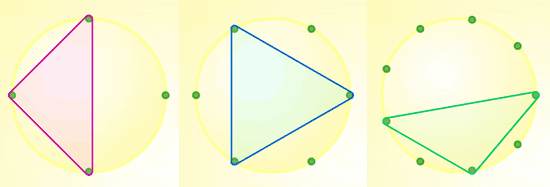Copyright © University of Cambridge. All rights reserved.
'Triangle Pin-down' printed from https://nrich.maths.org/
Show menu
Why use this activity?
This activity encourages children to explore the angles and relative lengths of sides of different triangles that can be made on pinboards. All the angles can be worked out using angles at the centre of a circle and the fact that the three angles in a triangle sum to $180^{\circ}$. No more complex geometric knowledge is required.
It might help for learners to have copies of blank peg boards to record their work on. These can be downloaded here:
Sheet of three-peg boards
Sheet of four-peg boards
Sheet of five-peg boards
Sheet of six-peg boards
Sheet of seven-peg boards
Sheet of eight-peg boards
Sheet of nine-peg boards
Teachers may find the article Angle Measurement: An Opportunity for Equity to be of interest.
Possible approach
The task can be introduced to the whole class using an interactive whiteboard and involving the children in contributing to decisions about their answers.
The children could then try the task for themselves either on computers or using the sheets of geoboard pictures. Once they have had a chance to explore, support them in feeding back their solutions to the rest of the class. Different groups might work on different numbers of pegs.
Key questions
The key questions are given in the text of the problem but here they are again:
Can you draw the same type of triangle on a three-pin board?
How many pins could there be on the board for you to be able to draw the same type of triangle?
Do you notice anything about the number of pins for which this is possible?
What kind of triangle is drawn on the six-pin board?
How many pins could there be on the board for you to be able to draw the same type of triangle?
Do you notice anything about the number of pins for which this is possible?
Can you name the type of triangle drawn on the nine-pin board?
On what size board could you draw the same type of triangle?
Do you notice anything about the number of pins for which this is possible?
Possible extension
You could extend the problem to pinboards with more pins on them and learners could explore the relationship between the number of pins, the shapes and angles involved.
Possible support
Children will find this easier if they have the opportunity to engage with the task on real pinboards. They may also find it difficult to record their results. Encorange them to draw or mark the lines from the centre to the edge of the triangles.
